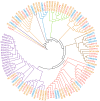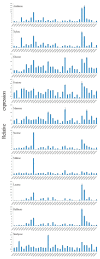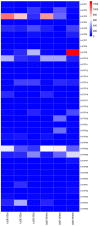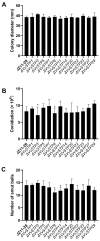The Identification, Characterization, and Functional Analysis of the Sugar Transporter Gene Family of the Rice False Smut Pathogen, Villosiclava virens
- PMID: 38203770
- PMCID: PMC10779207
- DOI: 10.3390/ijms25010600
The Identification, Characterization, and Functional Analysis of the Sugar Transporter Gene Family of the Rice False Smut Pathogen, Villosiclava virens
Abstract
False smut, caused by Villosiclava virens, is becoming increasingly serious in modern rice production systems, leading to yield losses and quality declines. Successful infection requires efficient acquisition of sucrose, abundant in rice panicles, as well as other sugars. Sugar transporters (STPs) may play an important role in this process. STPs belong to a major facilitator superfamily, which consists of large multigenic families necessary to partition sugars between fungal pathogens and their hosts. This study identified and characterized the STP family of V. viren, and further analyzed their gene functions to uncover their roles in interactions with rice. Through genome-wide and systematic bioinformatics analyses, 35 STPs were identified from V.virens and named from VvSTP1 to VvSTP35. Transmembrane domains, gene structures, and conserved motifs of VvSTPs have been identified and characterized through the bioinformatic analysis. In addition, a phylogenetic analysis revealed relationship between VvSTPs and STPs from the other three reference fungi. According to a qRT-PCR and RNA-sequencing analysis, VvSTP expression responded differently to different sole carbon sources and H2O2 treatments, and changed during the pathogenic process, suggesting that these proteins are involved in interactions with rice and potentially functional in pathogenesis. In total, 12 representative VvSTPs were knocked out through genetic recombination in order to analyze their roles in pathogenicity of V. virens. The knock-out mutants of VvSTPs showed little difference in mycelia growth and conidiation, indicating a single gene in this family cannot influence vegetative growth of V. virens. It is clear, however, that these mutants result in a change in infection efficiency in a different way, indicating that VvSTPs play an important role in the pathogenicity of virens. This study is expected to contribute to a better understanding of how host-derived sugars contribute to V. virens pathogenicity.
Keywords: STP; Ustilaginoidea virens; Villosiclava virens; expression pattern; false smut; pathogenicity; sugar transporter.
Conflict of interest statement
The authors declare no conflict of interest.
Figures







Similar articles
-
Current understanding on Villosiclava virens, a unique flower-infecting fungus causing rice false smut disease.Mol Plant Pathol. 2016 Dec;17(9):1321-1330. doi: 10.1111/mpp.12362. Epub 2016 Apr 13. Mol Plant Pathol. 2016. PMID: 26720072 Free PMC article. Review.
-
Two mating-type genes MAT1-1-1 and MAT1-1-2 with significant functions in conidiation, stress response, sexual development, and pathogenicity of rice false smut fungus Villosiclava virens.Curr Genet. 2020 Oct;66(5):989-1002. doi: 10.1007/s00294-020-01085-9. Epub 2020 Jun 22. Curr Genet. 2020. PMID: 32572596
-
UvVelC is important for conidiation and pathogenicity in the rice false smut pathogen Ustilaginoidea virens.Virulence. 2024 Dec;15(1):2301243. doi: 10.1080/21505594.2023.2301243. Epub 2024 Jan 19. Virulence. 2024. PMID: 38240294 Free PMC article.
-
The false smut pathogen Ustilaginoidea virens requires rice stamens for false smut ball formation.Environ Microbiol. 2020 Feb;22(2):646-659. doi: 10.1111/1462-2920.14881. Epub 2019 Dec 11. Environ Microbiol. 2020. PMID: 31797523 Free PMC article.
-
Ustilaginoidea virens, an emerging pathogen of rice: the dynamic interplay between the pathogen virulence strategies and host defense.Planta. 2024 Sep 11;260(4):92. doi: 10.1007/s00425-024-04523-x. Planta. 2024. PMID: 39261328 Review.
Cited by
-
Genome-wide identification and biochemical characterization of glycoside hydrolase gene family members in Tilletia Horrida.Mol Biol Rep. 2024 Nov 9;51(1):1136. doi: 10.1007/s11033-024-10059-w. Mol Biol Rep. 2024. PMID: 39520598
References
-
- Sun C., Wang Y., Yang X., Tang L., Wan C., Liu J., Chen C., Zhang H., He C., Liu C. MATE transporter GFD1 cooperates with sugar transporters, mediates carbohydrate partitioning and controls grain-filling duration, grain size and number in rice. Plant Biotechnol. J. 2023;21:621–634. doi: 10.1111/pbi.13976. - DOI - PMC - PubMed
MeSH terms
Substances
Supplementary concepts
LinkOut - more resources
Full Text Sources

